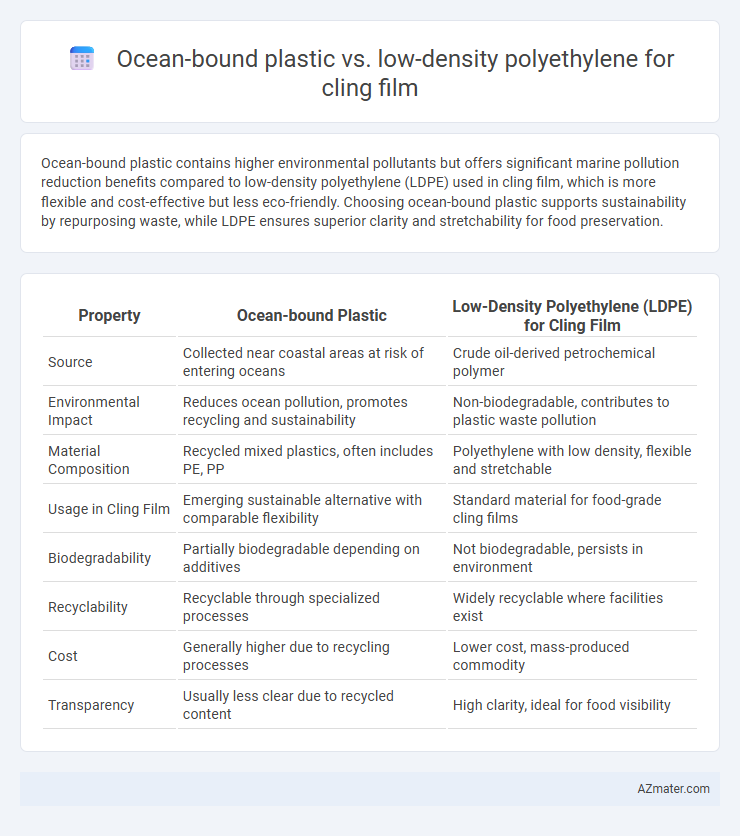Ocean-bound plastic contains higher environmental pollutants but offers significant marine pollution reduction benefits compared to low-density polyethylene (LDPE) used in cling film, which is more flexible and cost-effective but less eco-friendly. Choosing ocean-bound plastic supports sustainability by repurposing waste, while LDPE ensures superior clarity and stretchability for food preservation.
Table of Comparison
| Property | Ocean-bound Plastic | Low-Density Polyethylene (LDPE) for Cling Film |
|---|---|---|
| Source | Collected near coastal areas at risk of entering oceans | Crude oil-derived petrochemical polymer |
| Environmental Impact | Reduces ocean pollution, promotes recycling and sustainability | Non-biodegradable, contributes to plastic waste pollution |
| Material Composition | Recycled mixed plastics, often includes PE, PP | Polyethylene with low density, flexible and stretchable |
| Usage in Cling Film | Emerging sustainable alternative with comparable flexibility | Standard material for food-grade cling films |
| Biodegradability | Partially biodegradable depending on additives | Not biodegradable, persists in environment |
| Recyclability | Recyclable through specialized processes | Widely recyclable where facilities exist |
| Cost | Generally higher due to recycling processes | Lower cost, mass-produced commodity |
| Transparency | Usually less clear due to recycled content | High clarity, ideal for food visibility |
Introduction to Cling Film Materials
Cling film materials primarily comprise low-density polyethylene (LDPE), known for its flexibility, transparency, and moisture barrier properties, making it ideal for food wrapping. Ocean-bound plastic, sourced from waste recovered within 50 kilometers of coastlines, offers an eco-friendly alternative by reducing marine pollution while retaining similar functional characteristics to conventional LDPE. Utilizing ocean-bound plastic in cling films combines sustainability with performance, addressing environmental concerns without compromising product utility.
What Is Ocean-Bound Plastic?
Ocean-bound plastic refers to plastic waste collected within 50 kilometers of coastlines destined to enter the ocean, playing a critical role in reducing marine pollution. Low-density polyethylene (LDPE) is a common material used in cling film, valued for its flexibility and moisture resistance, but often contributes to ocean-bound plastic waste if improperly discarded. Utilizing ocean-bound plastic in manufacturing cling film can significantly decrease environmental impact by repurposing waste and preventing plastic from reaching marine ecosystems.
Overview of Low-Density Polyethylene (LDPE)
Low-Density Polyethylene (LDPE) is a widely used thermoplastic polymer characterized by its flexibility, transparency, and resistance to moisture, making it an ideal material for cling film applications. Unlike ocean-bound plastic, which originates from marine debris and requires extensive cleaning and processing, LDPE is synthesized through the polymerization of ethylene, ensuring consistent quality and performance. LDPE cling films exhibit excellent stretchability and sealability, providing effective food preservation while maintaining durability and ease of use.
Environmental Impact: Ocean-Bound Plastic vs LDPE
Ocean-bound plastic used for cling film reduces marine pollution by repurposing waste that would otherwise contaminate oceans, thereby supporting circular economy initiatives and mitigating ecosystem damage. In contrast, low-density polyethylene (LDPE), primarily derived from fossil fuels, contributes significantly to carbon emissions and persistence in landfills due to its slow biodegradation rate. Utilizing ocean-bound plastic not only diverts harmful debris from marine environments but also lowers the environmental footprint associated with traditional LDPE cling film production.
Manufacturing Process Differences
Ocean-bound plastic, derived from recovered waste near coastal areas, undergoes extensive cleaning, sorting, and reprocessing to remove contaminants before being pelletized for film extrusion. Low-density polyethylene (LDPE) is synthesized through polymerization of ethylene monomers using high-pressure processes, resulting in a pure, consistent resin ideal for manufacturing cling film. The manufacturing process of ocean-bound plastic requires additional steps to stabilize recycled polymers, whereas LDPE production emphasizes controlled polymerization conditions to ensure film clarity and flexibility.
Performance and Functionality Comparison
Ocean-bound plastic in cling film offers a sustainable alternative with comparable barrier properties and flexibility to low-density polyethylene (LDPE), but often includes impurities affecting uniformity. LDPE provides superior clarity, stretchability, and heat sealability, making it the industry standard for food preservation with consistent performance. While ocean-bound plastic films contribute to environmental impact reduction, LDPE remains preferred for functionality and reliability in packaging applications.
Recycling and End-of-Life Options
Ocean-bound plastic used in cling film offers a sustainable alternative by diverting waste from marine environments and enabling recycling processes that reduce plastic pollution. Low-density polyethylene (LDPE), the traditional material for cling film, is widely recyclable through specialized programs but often ends up in landfills due to contamination and collection challenges. Innovative recycling technologies and composting options for ocean-bound plastics enhance end-of-life solutions, promoting circular economy principles compared to conventional LDPE cling film.
Cost Implications of Each Material
Ocean-bound plastic offers a cost-effective alternative for cling film production due to its use of recycled materials, which can reduce raw material expenses and landfill fees. Low-density polyethylene (LDPE) remains cheaper in bulk purchases and benefits from established manufacturing processes, but rising fossil fuel prices can increase its overall cost. Evaluating both materials requires factoring in long-term environmental savings against fluctuating commodity prices and recycling infrastructure investments.
Consumer Perceptions and Market Trends
Consumer perceptions increasingly favor ocean-bound plastic for cling film due to its environmental benefits and sustainability credentials, aligning with growing eco-consciousness. Market trends reveal a shift toward recycled materials like ocean-bound plastic, driven by regulatory pressures and demand for zero-waste packaging solutions. Low-density polyethylene (LDPE) remains dominant for its cost-effectiveness and clarity but faces challenges as consumers prioritize biodegradable and recycled alternatives.
Future Prospects for Sustainable Cling Film
Ocean-bound plastic offers a promising alternative to traditional low-density polyethylene (LDPE) for sustainable cling film by reducing marine pollution and promoting circular economy practices. Innovations in recycling technology and biodegradable additives enhance the performance and environmental benefits of ocean-bound plastic cling films. Future developments may focus on improving material strength and transparency while maintaining compostability, enabling widespread adoption in eco-friendly packaging solutions.

Infographic: Ocean-bound plastic vs Low-density polyethylene for Cling film
 azmater.com
azmater.com